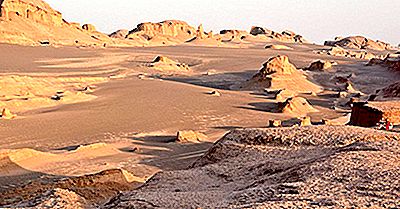
The stony deserts in eastern Lut cover (as a rubbly veneer) extensive pediplains, which are rock platforms that truncate bedrock and gently slope away from the foot of neighbouring hills. An extensive, black stony desert covers the basaltic Gandom Beryan plateau in the northwest of the core zone. The wind also strips hard rocky outcrops bare of soil, which leaves extensive stony desert pavements (hamada) with sand-blasted faceted stones (ventifacts) across about 12% of the area. Yardangs cover about one third of the area and are developed in consolidated lacustrine sediments (sands, silts, marls, evaporites) of mainly Plio-Pleistocene age that accumulated on the floor of the inland basin. In the Lut Desert some are up to 155 m high and their ridges can be followed for more than 40 km. Yardangs appear as massive and dramatic corrugations across the landscape with ridges and corridors oriented parallel to the dominant prevailing wind. Yardangs are bedrock features carved and streamlined by sandblasting, although they are also eroded by gullying from rainfall runoff and by mass movement. Consequently, the area possesses what many experts consider the world’s best examples of aeolian yardang landforms, as well as extensive stony deserts and dune fields.

The long duration strong winds propel 1 mm quartz sand grains at great velocity creating transportation of sediment and aeolian erosion (by sand blasting) on a colossal scale. It is perennial but highly saline by the time it enters the core zone so its banks are devoid of riparian vegetation and its channel is lined with salt crystals.Ī steep north-south pressure gradient develops across the region in spring and summer with the result that strong NNW-SSE winds blow across the area from between June and October each year. The largest incoming river, the Rud-e Shur, drains a catchment to the north of the area. The region often experiences Earth’s highest land surface temperatures: a temperature of 70.7C has been recorded within the property. The Lut Desert is situated in an interior basin surrounded by mountains, so it is in a rain shadow and, coupled with high temperatures, the climate is hyper-arid. In Persian language “Lut” refers to bare land without water and devoid of vegetation. At 2,278,015 ha the area is large and is surrounded by a buffer zone of 1,794,134 ha which varies in width between 10 and 30 kms. It is an arid continental subtropical area notable for a rich variety of spectacular desert landforms. The property Lut Desert is in the southeast of the Islamic Republic of Iran (hereinafter referred to as Iran) and straddles the three Iranian Provinces of Kermān, Sistāno Balūchestān and Khorāsān-e Jonūbi.

The UNESCO World Heritage Committee issued the following Statement of Outstanding Universal Value at the time of inscription: Lut Desert MIXED NATURAL & CULTURAL WORLD HERITAGE SITEĢ016: Inscribed on the World Heritage List under natural criteria vii and viii. Overall, the property contains a globally significant selection of geological features in an area which is at low risk of human pressure through its relative isolation and inhospitable conditions. Additionally, the property also contains distinctive salt pans, stone pavements and the lava covered Gandom Beryan plateau. Within these landscapes are some of the world’s highest sand dunes, largest nebkhas – sand dunes around vegetation – and longest yardangs – ridges running parallel to the wind. The erosive abilities of these environmental processes work in conjunction to create some of the world’s best examples of striking desert landscapes. The property is characterised by its dramatic environmental conditions which include very low levels of precipitation, long periods of high wind and some of the hottest recorded temperatures on earth.


The Lut Desert is a large hyper-arid area in the south-east of Iran which in Persian means devoid of water and vegetation. Inscription year 2016 Country Islamic Republic Of Iran Lut Desert Islamic Republic of Iran


 0 kommentar(er)
0 kommentar(er)
